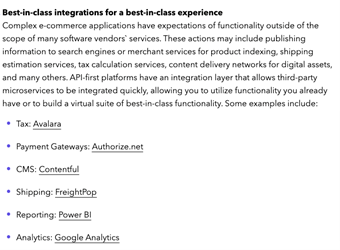Headless Thoughts: Sitecore and the Shift to Composable DXP (Analytics)
Matthew McQueeny - Relationships & Community Lead
21 Mar 2022
As Sitecore and the overall Digital Experience Platform (DXP) marketplace move towards a composable, headless, API-first architecture, there are now a plethora of best-in-class options available for delivering on the digital experience up, down, and across your technology stack.
Before the shift to “Composable DXP,” platform providers were bundled and “all-in-one,” as they sought to offer all the functionality, features, and services you require in one place. But it is a difficult proposition to be all things to all people.
In economics, there is a concept called the conglomerate discount, which “refers to the tendency of markets to value a company with a diversified group of business as less than the sum of its parts.”
A similar effect has taken place in the traditional DXP market.
Looking back over the years, it made sense at one time to offer a consolidated solution, a single sign-on with access to content management, analytics, email marketing, commerce, personalization, visualization, etc. But what happens when a market leader – or several market competitors – separate themselves in any of these disciplines?
Should a Sitecore, for instance, continue to develop, maintain, and improve a proprietary analytics tool when Google Analytics is the provider of choice for 29 million sites and 87% of the most popular 10,000 sites? Should it continue to compete, at what cost, and for what benefit? The API-first architecture gives the customer the opportunity to integrate with Google Analytics and benefit from the value of its network effects (Google Analytics has always kind of been headless, huh?).
Following this example, the chances are that your organization is already using Google Analytics and building custom dashboards, creating custom events, and maintaining historical data. The workflow and collaboration between organizational departments may already be in place. Your team may be experts, even certified, in Google Analytics.
With an all-in-one solution, the promise is enticing to move there and centralize your digital activities. But even in the rosiest scenario, employee retraining is going to be a necessity. And what if something goes wrong on that platform? Who will help with troubleshooting? Is there someone in-house? A consultant? Are there enough users of the specific product that forums exist to help answer questions?
Composable DXP is as much about using best-of-breed technologies as it is about allowing your team to continue using the technologies and tools that they prefer.
Sitecore said as much in an article about B2B marketplace architecture (see screen capture), where the company recommends using several best-in-class integrations, including Google Analytics.

Composable DXP makes it possible to create your own symphony: a tool for personalization, another for commerce, another for analytics, one for content management, DAM (Digital Asset Management), PIM (Product Information Manager), and on. The API-first architecture can connect and/or decouple all the tools and services as needed. And there is no dissonance created by overengineering and overcomplicating the directive for all your tools to be in the same toolshed. Your team continues its work unimpeded - choosing the solutions that best suit its needs - with connections made through APIs and microservices.

Matthew McQueeny
Matt is a digital marketing professional and web project manager with over 15 years of experience. He has worked with clients ranging from Fortune 500 to startups. Industries of digital project experience include healthcare, publishing, technology, telecommunications, education, retail, entertainment, manufacturing, and transportation. In 2023, Matt was awarded his first Sitecore MVP, in recognition for his work in the Sitecore community.
He loves the intersection of technology, marketing, and communications. Throughout his career, he worked with many licensed and open-source content management systems, in editorial, social media strategy and advertising, search engine marketing, lead generation, analytics, and podcasting.



Share on social media